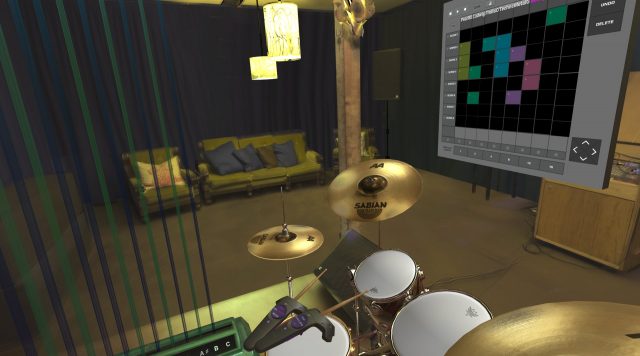
Chroma Coda has introduced The Music Room, a collection of MIDI controllers that you can play in virtual reality and use to control your hardware and software instruments.
The application creates a virtual reality view of various types of MIDI controllers that you can play, generating MIDI information that can be used to control any virtual instrument or DAW.
Here’s the official video intro:
Here’s an overview of The Music Room from the 2016 Summer NAMM Show:
https://www.youtube.com/watch?v=Ujn4nq0gA
Talking about virtual reality can be a bit like dancing about architecture, so Chroma Coda has shared several hands-on video demos, embedded below, that showcase how it works:
Key Features:
- The Music Room is a MIDI controller and can control any DAW. The bundled sampler is VST plugin.
- The Music Room allows you to strum, slide, bend and drum naturally and expressively. Play drums, laser harp and our chord harp.
- With MPE, The Music Room can control pitch, volume (aftertouch), timbre, note on and off velocity and 3 more dimensions continuously per note.
- Play carefully scanned drums and cymbals from Pearl, Ludwig, Sabian, Zildjian, DW and Gretsch.
- Includes Bitwig 8-Track, which lets you loop and record instruments from VR, select presets and launch clips.
- It’s designed to be low latency and high performance.
Pricing and Availabilty
The Music Room is available now for US $129 for the HTC Vive. At launch The Music Room supports the HTC Vive running on Windows. They plan to support Mac & Linux as soon as HTC supports them. Support for the Oculus Rift with Touch and PlayStation VR are also planned.

I am a gearslut and own a HTC Vive and use BITWiG but still won’t buy this without dew looking a demo,,,,,..get a demo out so we can try it….there is already pretty good VR.music software on steam for under 20 bucks…
Yes, i suggested a demo to the dev as well. I’m disappointed this software showed a realistic looking laser harp in the original video. What they actually released was something with dark cotton threads instead of lasers. Might sound trivial but one of the draws for me with this software was that laser harp they showed in the promo video.
I can add a glow look mode for you if you want, as an option. It’s easy to do. It just eats a little bit more performance and it’s a lot less usable, as looking through a bunch of bright lasers is problematic as it’s quite bright, at least for me to use all day. That’s why we’ve gone for the darker strings. It isn’t really similar to real world laser harps, as it’s much more expressive.
This looks amazing. If ever there was a reason to get VR it was something like this. You could imagine the studio of your dreams. Imagine being able to build synths later on like a vr Reaktor.
The only fly in the ointment is the cost of VR! Too expensive at the moment …..as well as a new computer needed……most would agree.
It depends on your understanding of vr. It has dropped in price massively since oculus came on the scene. When 4k monitors first appeared they cost 2000 dollars. Mostly no one complained they were too expensive because most people were smart enough to realize the price would fall. Pre oculus era sony wanted 1500 dollars for its hmz vr. Now we have massively improved vr significantly cheaper than pre – oculus era hardware.
Desktop vr at this stage isn’t for casual users. It’s for serious simulation fans, developers.
Not everyone needs a new PC to run it. My pc was already 4 years old and i only upgraded the gpu because of the flight sims i run.
This software doesn’t need a high spec gaming pc.
I am a drummer and have Vive but wont buy this without a demo first
I think I’d enjoy the virtual reality experience for about an hour. I think I’d enjoy playing virtual drums for about 3 minutes. The latency rage would build, then I’d tap out.
The implication is that if you can’t have the real thing, a virtual version is the next best thing. It just has to be really dialed in. This still feels like it is in its infancy.
The exception I’d make is AeroDrums which has shown an impressively responsive system.
Do you have latency data to share?
It might be unfair to assume the latency is out-of-bounds. Based on what I saw in the video, it looked/sounded pretty unwieldy and awkward. It might be hard to measure, but not impossible. Hopefully they’ll post honest specs on that.
I show in a few of the videos what the latency settings are set to. 3-4 ms is easily achievable. You can get tight hihat patterns and we haven’t had any complaints about latency since launch. We’ve got some very happy emails about how low the latency is.